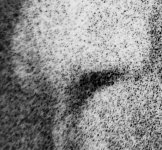peripatetic
Well-known
For the scanning gurus.
I mostly use the C41 BW films, Ilford XP2 and Kodak BW400CN.
Because:
I am (still) considering purchasing a MF outfit, and because I can't afford a Coolscan 9000 am wondering what resolution scans I should pay for. The labs seem to base their prices on the final output size (I guess they have to base it on something), but clearly there is no point in paying for a 100Mb scan when a 20Mb scan will do the same job with the film I happen to be using.
So here is my question: At what point does one reach severely diminishing returns with a given film type?
Is there any point in scanning XP2 at 4000dpi? Will everything beyond 2000dpi be just extra grain/noise? My intuition says that for ISO400 films there is probably little extra detail in the 4000dpi scan compared to a 2000dpi scan. With Velvia50 I would expect there is extra detail beyond even 4000dpi.
Does anyone have a handy matrix for optimum scan resolutions for different film types? [Or have I just got hold of the wrong end of the stick with this notion?]
It also has longer term purchasing implications, for example if I do 90% of my shooting with BW ISO 400 films (C41 or silver), it may be that there is no real point in getting a Coolscan9000 over a V750 for example. The V750 is reported as having a 2500dpi optical resolution, if the film only needs 2000dpi then I can spend the money I might have spent on some extra lenses, or a holiday, gift for the wife, etc.
Thanks in advance.
Craig
I mostly use the C41 BW films, Ilford XP2 and Kodak BW400CN.
Because:
- 400 ISO
- Easy to get processed in a high-street lab.
- Allegedly good for scanning.
I am (still) considering purchasing a MF outfit, and because I can't afford a Coolscan 9000 am wondering what resolution scans I should pay for. The labs seem to base their prices on the final output size (I guess they have to base it on something), but clearly there is no point in paying for a 100Mb scan when a 20Mb scan will do the same job with the film I happen to be using.
So here is my question: At what point does one reach severely diminishing returns with a given film type?
Is there any point in scanning XP2 at 4000dpi? Will everything beyond 2000dpi be just extra grain/noise? My intuition says that for ISO400 films there is probably little extra detail in the 4000dpi scan compared to a 2000dpi scan. With Velvia50 I would expect there is extra detail beyond even 4000dpi.
Does anyone have a handy matrix for optimum scan resolutions for different film types? [Or have I just got hold of the wrong end of the stick with this notion?]
It also has longer term purchasing implications, for example if I do 90% of my shooting with BW ISO 400 films (C41 or silver), it may be that there is no real point in getting a Coolscan9000 over a V750 for example. The V750 is reported as having a 2500dpi optical resolution, if the film only needs 2000dpi then I can spend the money I might have spent on some extra lenses, or a holiday, gift for the wife, etc.
Thanks in advance.
Craig



